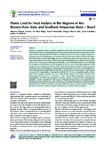Por favor, use este identificador para citar o enlazar este ítem:
http://www.infoteca.cnptia.embrapa.br/infoteca/handle/doc/1028209Registro completo de metadatos
| Campo DC | Valor | Lengua/Idioma |
|---|---|---|
| dc.contributor.author | FERREIRA, A. B. | pt_BR |
| dc.contributor.author | MING, L. C. | pt_BR |
| dc.contributor.author | HAVERROTH, M. | pt_BR |
| dc.contributor.author | DALY, D. C. | pt_BR |
| dc.contributor.author | CABALLERO, J. | pt_BR |
| dc.contributor.author | BALLESTÉ, A. M. | pt_BR |
| dc.date.accessioned | 2015-11-09T11:11:11Z | pt_BR |
| dc.date.available | 2015-11-09T11:11:11Z | pt_BR |
| dc.date.created | 2015-11-09 | pt_BR |
| dc.date.issued | 2015 | pt_BR |
| dc.identifier.citation | International Journal of Phytocosmetics and Natural Ingredients, Boston, v. 2, n. 9, 2015. | pt_BR |
| dc.identifier.uri | http://www.infoteca.cnptia.embrapa.br/infoteca/handle/doc/1028209 | pt_BR |
| dc.description | Malaria is a parasitic disease caused by organisms of the genus Plasmodium. The present study examined wild and cultivated plants used to treat malaria and associated symptoms by riparian communities in the Municipalities of Pauini and Xapuri in Amazonas and Acre states, respectively. During the year 2013 86 persons were interviewed in 9 rural communities in Pauini and Xapuri that were known for their knowledge and use of medicinal plants, After each interview, walks were made (walk in the woods), with the main informant of the family, for identification of plants and to collect the samples of the species indicated. A total of 86 plant species were indicated by seringueiros and ribeirinhos for the treatment of malaria and for associated symptoms, while 26 species were indicated exclusively for the treatment of malaria, of which 2 had no previous indication of use for that purpose. Among the plants mentioned in the survey, we highlight the 10 most cited and used by respondents living in the 2 regions. They are: quina-quina - Stenostomum acreanum (40), carapanaúba - Aspidosperma nitidum (39), Picão ou carrapicho-agulha - Bidens pilosa (29), Copaíba - Copaifera sp. (21), melão-de-são-caetano - Momordica charantia (19), quina-quina - Geissospermum reticulatum (16), Paracanaúba/carapanúba - Aspidosperma megaphyllum (14), Amor-Crescido/Alecrim - Portulaca pilosa (11) species in test 2 (8) and picão-plantado - Leonotis nepetifolia (7). The regions of Pauini and Xapuri have an important flora to prospect promising plants for new antimalarial drug, communities studied have a great knowledge about the forest and their members have used medicinal plants for malaria and its symptoms. | pt_BR |
| dc.language.iso | eng | eng |
| dc.rights | openAccess | eng |
| dc.subject | Conhecimento tradicional | pt_BR |
| dc.subject | Comunidade ribeirinha | pt_BR |
| dc.subject | Doença tropical | pt_BR |
| dc.subject | Tropical disease | pt_BR |
| dc.subject | Enfermedad tropical | pt_BR |
| dc.subject | Xapuri (AC) | pt_BR |
| dc.subject | Acre | pt_BR |
| dc.subject | Pauini (AM) | pt_BR |
| dc.subject | Amazonas | pt_BR |
| dc.subject | Conocimiento tradicional | pt_BR |
| dc.subject | Plantas medicinales | pt_BR |
| dc.subject | Medicina tradicional | pt_BR |
| dc.title | Plants used to treat malaria in the regions of Rio Branco - Acre state and southern Amazonas state - Brazil. | pt_BR |
| dc.type | Artigo de periódico | pt_BR |
| dc.date.updated | 2017-08-30T11:11:11Z | pt_BR |
| dc.subject.thesagro | Planta medicinal | pt_BR |
| dc.subject.thesagro | Tratamento | pt_BR |
| dc.subject.thesagro | Parasito | pt_BR |
| dc.subject.thesagro | Protozoário | pt_BR |
| dc.subject.thesagro | Etnobôtanica | pt_BR |
| dc.subject.nalthesaurus | Indigenous knowledge | pt_BR |
| dc.subject.nalthesaurus | Traditional medicine | pt_BR |
| dc.subject.nalthesaurus | Medicinal plants | pt_BR |
| dc.subject.nalthesaurus | Plasmodium | pt_BR |
| dc.subject.nalthesaurus | malaria | pt_BR |
| riaa.ainfo.id | 1028209 | pt_BR |
| riaa.ainfo.lastupdate | 2017-08-30 -03:00:00 | pt_BR |
| dc.identifier.doi | 10.15171/ijpni.2015.09 | pt_BR |
| dc.contributor.institution | Almecina Balbino Ferreira, Universidade de São Paulo; Lin Chau Ming, Unesp; MOACIR HAVERROTH, CPAF-AC; Douglas Charles Daly, The New York Botanical Garden; Javier Caballero, Universidade Nacional Autónoma de Mexico; Andrea M. Ballesté, Universidade Nacional Autónoma de Mexico. | pt_BR |
| Aparece en las colecciones: | Artigo de divulgação na mídia (CPAF-AC)  | |
Ficheros en este ítem:
| Fichero | Descripción | Tamaño | Formato | |
|---|---|---|---|---|
| 25756.pdf | 477.05 kB | Adobe PDF |  Visualizar/Abrir |









